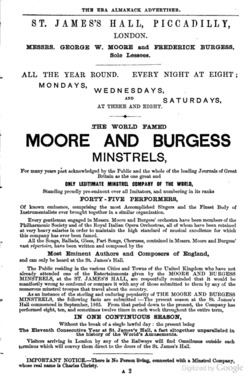- Christy's Minstrels
-
 1844 sheet music cover for a collection of songs by the Christy's Minstrels. George Christy appears in the circle at top.
1844 sheet music cover for a collection of songs by the Christy's Minstrels. George Christy appears in the circle at top.
Christy's Minstrels, sometimes referred to as the Christy Minstrels, were a blackface group formed by Edwin Pearce Christy, a well-known ballad singer, in 1843,[1] in Buffalo, New York. They were instrumental in the solidification of the minstrel show into a fixed three-act form.[2] The troupe also invented or popularized "the line", the structured grouping that constituted the first act of the standardized 3-act minstrel show, with the interlocutor in the middle and "Mr. Tambo" and "Mr. Bones" on the ends.
Contents
Early years
In 1846 they first performed in Polmer's Opera House in New York City. From March 1847, they ran for a seven-year stint at New York City's Mechanics' Hall (until July 1854).
After performing at a benefit performance for Stephen Foster in Cincinnati, Ohio, on August 25, 1847, the group specialized in performances of Foster's works. Foster sold his song, Old Folks at Home, to Christy for his exclusive use. The troupe's commercial success was phenomenal: Christy paid Foster $15,000 for the exclusive rights to the song.[3]
Besides Christy himself, the troupe originally included Christy's stepson George Christy, often considered the greatest blackface comic of the era. By September 1855 however both George and Edwin Christy had retired from the group; although the company continued, still calling themselves 'Christy's Minstrels', until Edwin P. Christy took out an injunction to prevent them.[4] Christy was emotionally affected by the American Civil War, and committed suicide in 1862.
Christy Minstrels in Britain
J. W. Raynor and Earl Pierce formed a new troupe, using many of the former Christy Minstrel members. It opened in London, England as "Raynor & Pierce's Christy Minstrels" at the St. James's Theatre on 3 August 1857. They then performed at the Surrey Theatre and later the "Polygraphic Hall" on King William Street, where they appeared for ten months. "Nellie Grey" by Michael Balfe, as sung by Raynor, became popular. In 1859, the troupe moved to the St. James's Hall (Liverpool), performing for another four months and then touring the British provinces. It then returned to Polygraphic Hall, disbanding in August 1860. The success of this troupe led to the phrase "Christy Minstrels" coming to mean any blackface minstrel show. Soon, four new companies were formed, each claiming to be the "original" Christy Minstrels, because they each boasted one or two former members of the old troupe. One group played in Dublin at the Chester Theatre in 1864, moving to London at the Standard Theatre in Shoreditch in 1865. Three months later, it moved to St. James's Hall, where it began a run of 35 years until 1904. Eventually, the original members of that troupe retired or died, leaving only “Pony” Moore and Frederic Burgess surviving into the 1870s. Therefore, the troupe changed its name to the "Moore & Burgess's Minstrels". Other groups continued to use the title "Christy", but historian Frank Andrews describes their quality as poor. Some of them continued to perform into the twentieth century.[5]
New Christy Minstrels
The New Christy Minstrels, a folk group from the 1960s, were named with reference to this group, although they never performed in blackface.
Notes
- ^ Or possibly in 1842: In 1855 the New York Times reported a law case in which Christy took out an injunction against the troupe continuing to call themselves "Christy's Minstrels" even though he no longer had a connection with them; in it the 1842 date is given. "In 1842 Edwin P. Christy established in this city the band, which since has become so celebrated as "Christy's Minstrels".New York Times September 14, 1855.
- ^ New York Times, September 14, 1855: during a legal dispute about the continuing use of the name 'Christy's Minstrels' after the departure of E.P.Christie, the surviving members of the troupe admitted to giving a performance at the Athenaeum hall, Brooklyn, on September 10, 1855 which "consisted of musical, terpsichorean and humorous exhibitions of an Ethiopian character."
- ^ Lott, 1993, 267
- ^ According to the New York Times report, Edwin Christy took out an injunction against the troupe calling themselves 'Christy's Minstrels' "though there was no person among them by the name of Christy." The troupe, then headed by a Joseph Murphy, did perform on September 10th as 'Christy's Minstrels' and were sued for contempt of court. The judge however, Mr Justice Clerke, dismissed the contempt charge after the defendants claimed they had announced to the audience prior to the performance that they were not now 'Christy's Minstrels' - though they expressed an intention of continuing under a different name. New York Times September 14, 1855:'LAW INTELLIGENCE: MINSTRELS IN COURT'
- ^ Article by Michael Walters, citing Andrews, Frank, Talking Machine Review, November 1977 issue
References
- Edwin Pearce Christy, at the University of Pennsylvania site. Accessed 6 Sept 2005.
- Lott, Eric (1993). Love and Theft: Blackface Minstrelsy and the American Working Class. Oxford University Press. ISBN 0-19-509641-X.
- Toll, Robert C. (1974). Blacking Up: The Minstrel Show in Nineteenth-century America. New York: Oxford University Press.
- Foster and the Christy Minstrels
External links
Categories:- Blackface minstrel troupes
- History of Buffalo, New York
- 1843 establishments in the United States
- 1904 disestablishments
Wikimedia Foundation. 2010.

